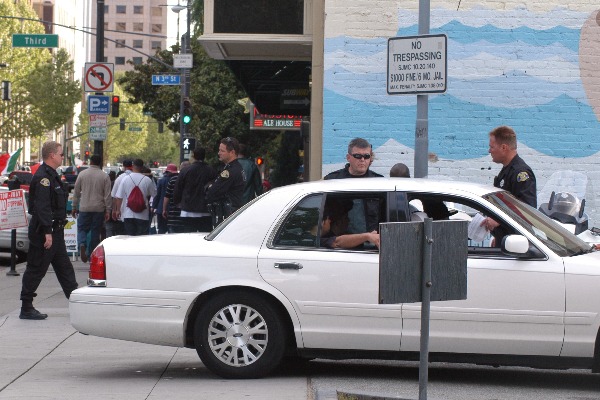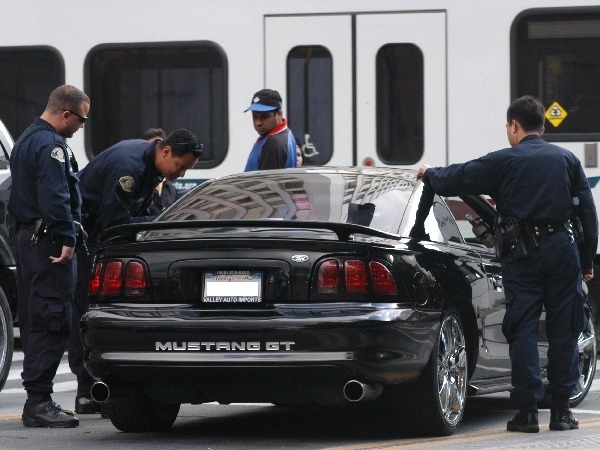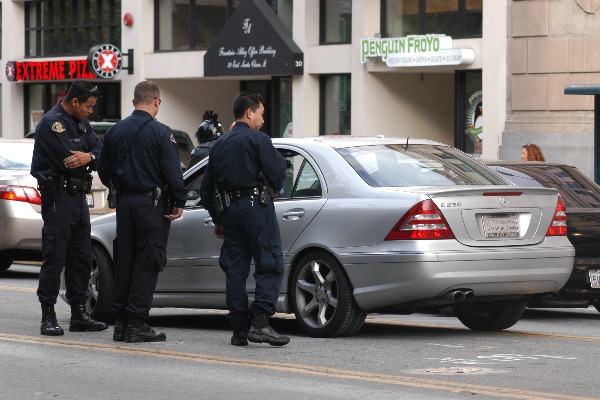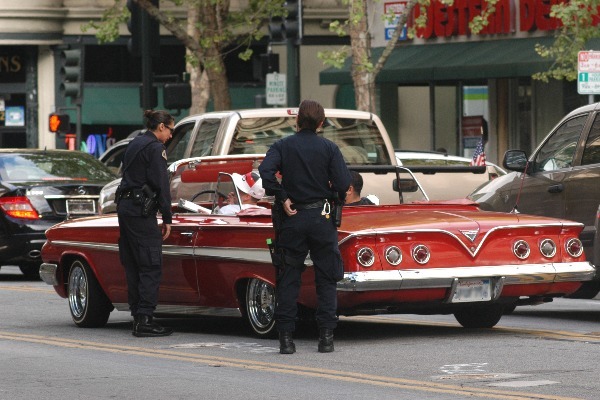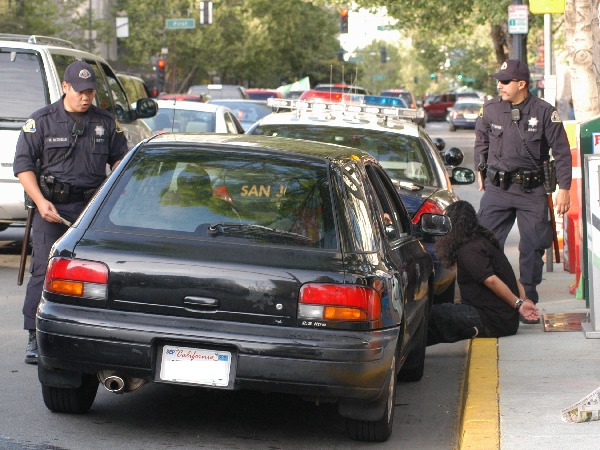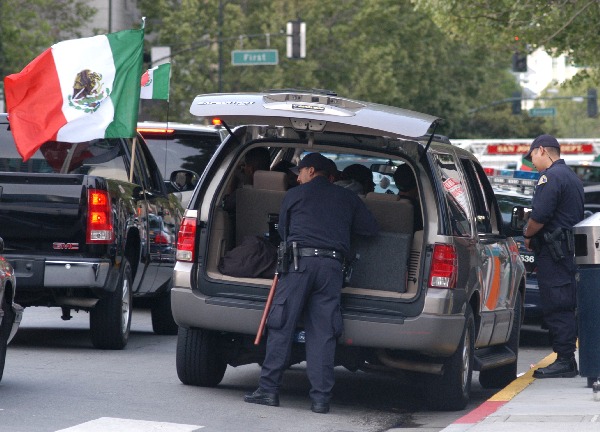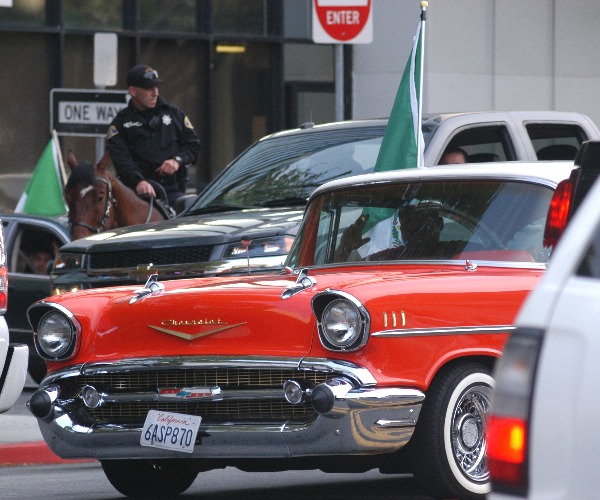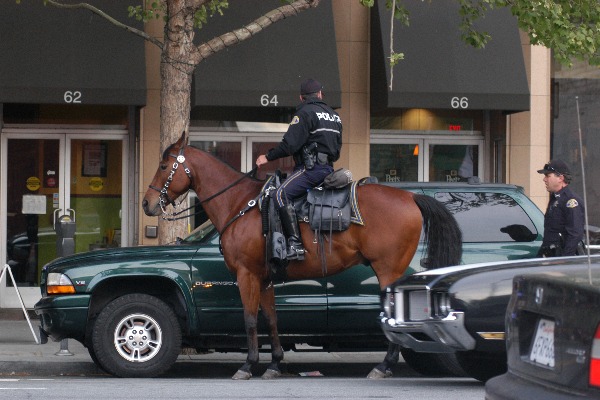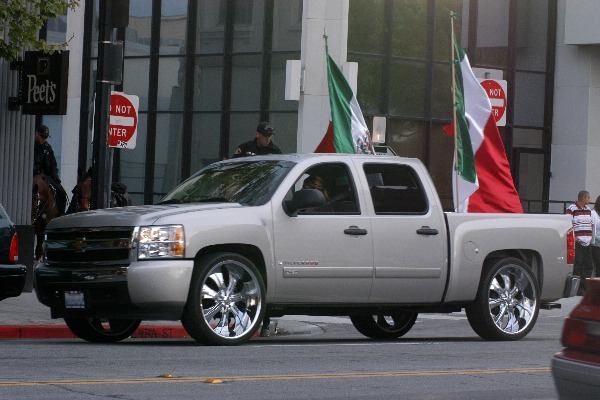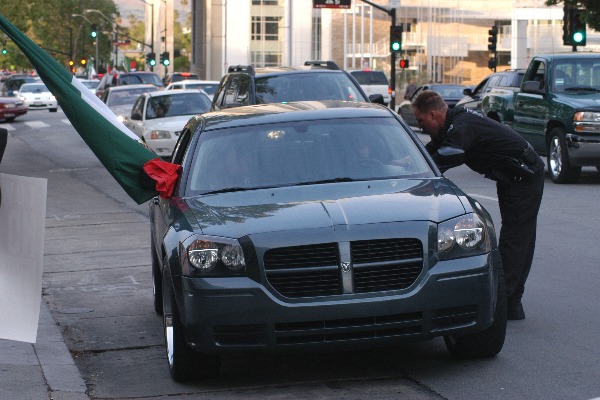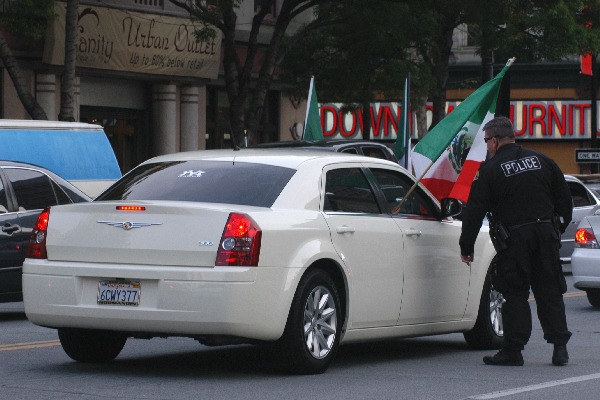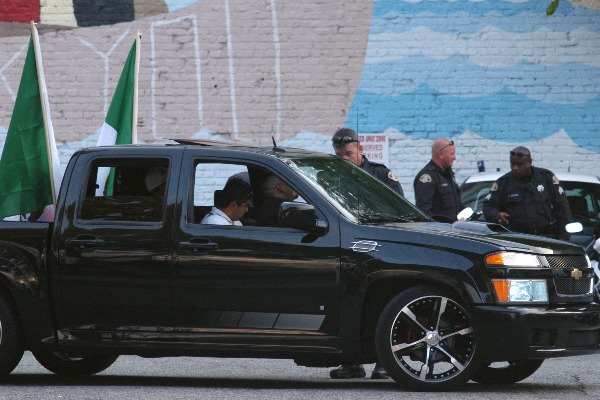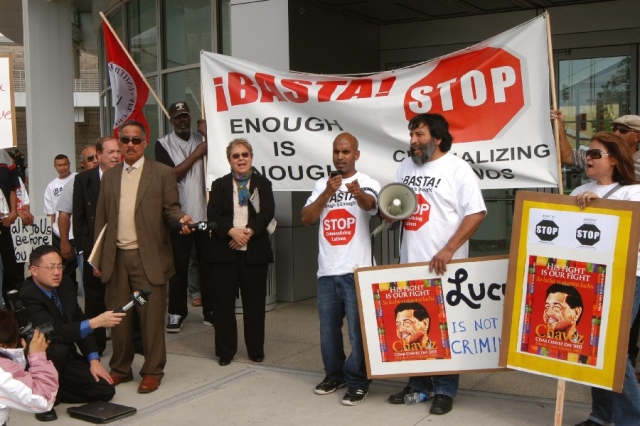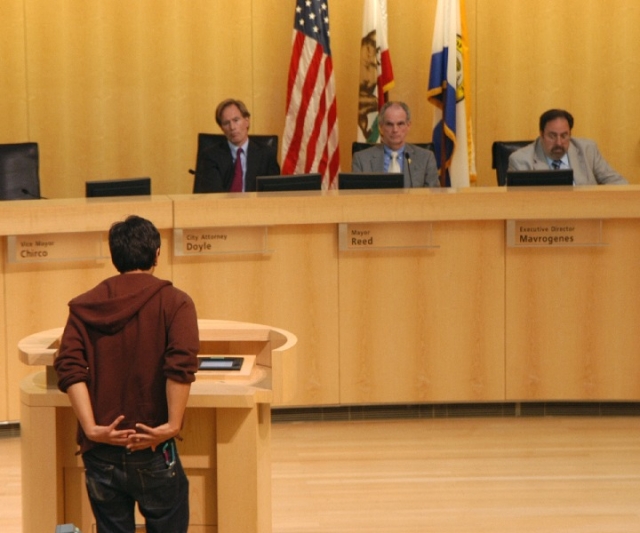From the Open-Publishing Calendar
From the Open-Publishing Newswire
Indybay Feature
San José Police Department Targets Latinos, Photo Survey Shows
Photographic documentation of 14 daytime vehicle stops per hour within a 4-block section of Santa Clara Street during Cinco de Mayo celebrations substantiates a deliberate policy of targeting Latinos by the San José Police Department. Only a citizen police review board can represent a broad range of community interests and ensure police accountability.
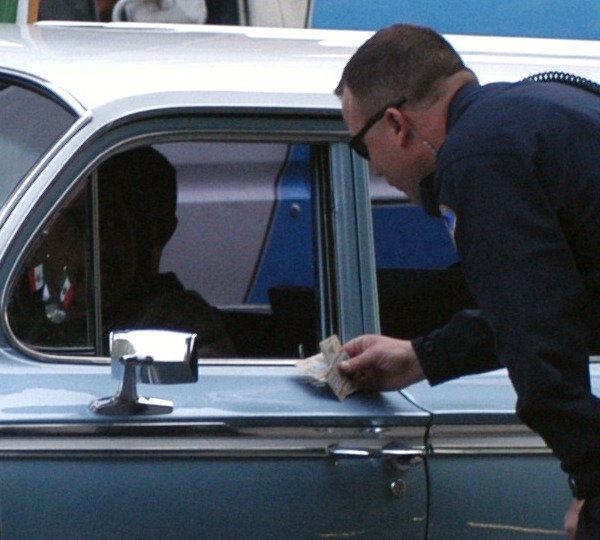
With Mexican flags and music, Cinco de Mayo was celebrated in San José on May 3, 2009 with the usual pride and enthusiasm. People were just trying to have some safe fun driving slowly down Santa Clara Street, the main thoroughfare from Mexican Heritage Plaza and the east side of the city into downtown. Some were showing off their lowriders and colors of Mexico. Others came by foot, bicycle, bus, and lightrail. The crowds were smaller than previous years, but that did not stop San José police from targeting Latinos.
This writer walked along Santa Clara Street from Fourth Street to Market Street for a half hour from approximately 6:10 pm to 6:40 pm and again from about 7:10 pm to 7:40 pm. The time in between was spent walking down Market Street to San Carlos Street and Almaden Boulevard. Standing well out of the way of police and the stopped vehicles, I photographed each incident to document the police stop and also to let police know that they were being monitored. Police behavior is known to be better whenever citizens are deliberately watching. Grassroots organizations such as Copwatch and Silicon Valley De-Bug use these tactics to monitor and discourage police abuses.
During those two half-hour intervals on four blocks of Santa Clara Street, there were no fewer than 14 separate cars stopped by San José police in what appeared to be deliberate fishing expeditions. This amounts to nearly one stop every four minutes. In the majority of cases, a citation was issued. One case led to an arrest, with a passenger being asked to drive the car home. Another case involved a time-consuming inspection of the rear of the vehicle. Several cars were eventually released without citation. Due to keeping a distance from the incidents, in only one case could I overhear the police conversation. It was a case of driving without a license, which resulted in a citation and calling for another family member to come and drive the car home.
Driving without a license is a justifiable citation and serves to remove untrained and untested (hence, potentially unsafe) drivers from the road. But in the case of undocumented immigrants, it has drastic and virtually irreversible consequences. Undocumented status is believed to be the leading reason for driving without a license, because undocumented immigrants are not currently eligible for driver licenses in California. In sprawling suburbs, working people need to drive to work and to perform family errands. Yet a single citation for driving without a license could trigger judicial proceedings leading to referral to Immigration and Customs Enforcement (ICE) and eventual deportation. It could also disqualify an immigrant from any future application for legal immigration or permanent residency.
The campaign for driver license eligibility for all residents was an early trigger for the immigrant rights movement in California, and a major initial campaign for such local organizations as Voluntarios de la Comunidad, which has been perhaps the single most visible and persistent leader of the May Day immigrant rights marches in San José since 2006.
By contrast, during the half-hour walk along Market Street, San Carlos Street, and Almaden Boulevard from 6:40 pm until 7:10 pm, there was not a single police car on patrol. Yet the largest single gathering of people on the street at that time was the crowd of mostly non-Latinos gathering for a public event at the Montgomery Theater at Market and San Carlos Streets. So why was the police presence so intensely focused on just four blocks of Santa Clara Street where Latinos were out to enjoy Cinco de Mayo? Why do San José police not implement the same sorts of random checkpoints during other crowded festivals like the Saint Patrick’s Day parade, Veterans’ Day parade, Tet Festival, Independence Day, Amgen Tour of California, or Christmas in the Park?
The most troubling observation on Cinco de Mayo was the police stop of a lowrider Chevrolet station wagon in the median of Santa Clara Street near First Street at around 7:25 pm. The San José police officer apparently asked for the driver licenses of all persons in the vehicle, not just that of the driver. The lead photograph shows him holding three California driver licenses in his right hand. If the stop was for a potential traffic violation, only the license of the driver should have been requested. If the passengers were in violation, for example, for possession of open alcoholic beverages, they would have been cited. The car was eventually released without citation, suggesting that no violation was found. Alternatively, if the stop was for a general identity check, then it was a fishing expedition. Finally, if the stop was effectively an immigration check, it would presumably be under the 8 CFR 287 (g) program, in which Chief Rob Davis has never publicly agreed to participate.
What was going on here? Chief Davis and the City of San José owe residents in general, and the Hispanic community in particular, an explanation.
The controversy over alleged San José police targeting of Latinos began years ago with charges that police made more arrests during Cinco de Mayo celebrations than at any other time of the year in apparent response to a few years of reported rowdiness and public drunkenness. These allegations against the police were given more weight when the San Jose Mercury News (Sean Webby, “Drunkenness arrests in San Jose outpace other California cities,” October 18, 2008, http://www.mercurynews.com/san-jose-public-drunkenness/ci_10755739) reviewed arrest data, showing that San José had by far the highest arrest rate for public drunkenness in California in 2007. The 4,661 arrests for public drunkenness in San José exceeded both San Diego and Los Angeles, which have much larger populations.
Still more troubling was the revelation that 57 per cent of those charged with public drunkenness in San José in 2007 were Hispanic. Yet Hispanics represented only 32 per cent of the city’s population in that year.
The attitude of San José’s Chief of Police, Robert L. Davis, has also changed dramatically over the past two years. While Davis went out of his way on March 31, 2007 to walk with the Hispanic community on César Chávez’s birthday and promised that good relations between the police department and the Hispanic community were more important than helping to enforce federal immigration regulations, the current practice of fishing for misdemeanor violations in the Hispanic community is doing just the opposite – alienating the community and pushing many undocumented immigrants (even if unintentionally) into deportation proceedings.
At the same time, community activists emphasize that the community is not against the police, but really wants to work with the police to ensure public safety for all.
Finally, it is worth observing that difficulties in appointing and retaining an Independent Police Auditor at $170,000 per year in San José illustrate that the IPA may be neither the best nor most cost-effective solution to police oversight. The cities of Oakland and Berkeley have successfully used citizen police review boards (CPRB) to process complaints, conduct hearings, mediate complaint cases, analyze operational deficiencies, and make recommendations for change. The Oakland CPRB released its 67-page report in March, detailing 74 complaints received in 2008 and their resolutions. In view of San José’s present difficulties with the community, San José should strongly consider this approach.
This writer walked along Santa Clara Street from Fourth Street to Market Street for a half hour from approximately 6:10 pm to 6:40 pm and again from about 7:10 pm to 7:40 pm. The time in between was spent walking down Market Street to San Carlos Street and Almaden Boulevard. Standing well out of the way of police and the stopped vehicles, I photographed each incident to document the police stop and also to let police know that they were being monitored. Police behavior is known to be better whenever citizens are deliberately watching. Grassroots organizations such as Copwatch and Silicon Valley De-Bug use these tactics to monitor and discourage police abuses.
During those two half-hour intervals on four blocks of Santa Clara Street, there were no fewer than 14 separate cars stopped by San José police in what appeared to be deliberate fishing expeditions. This amounts to nearly one stop every four minutes. In the majority of cases, a citation was issued. One case led to an arrest, with a passenger being asked to drive the car home. Another case involved a time-consuming inspection of the rear of the vehicle. Several cars were eventually released without citation. Due to keeping a distance from the incidents, in only one case could I overhear the police conversation. It was a case of driving without a license, which resulted in a citation and calling for another family member to come and drive the car home.
Driving without a license is a justifiable citation and serves to remove untrained and untested (hence, potentially unsafe) drivers from the road. But in the case of undocumented immigrants, it has drastic and virtually irreversible consequences. Undocumented status is believed to be the leading reason for driving without a license, because undocumented immigrants are not currently eligible for driver licenses in California. In sprawling suburbs, working people need to drive to work and to perform family errands. Yet a single citation for driving without a license could trigger judicial proceedings leading to referral to Immigration and Customs Enforcement (ICE) and eventual deportation. It could also disqualify an immigrant from any future application for legal immigration or permanent residency.
The campaign for driver license eligibility for all residents was an early trigger for the immigrant rights movement in California, and a major initial campaign for such local organizations as Voluntarios de la Comunidad, which has been perhaps the single most visible and persistent leader of the May Day immigrant rights marches in San José since 2006.
By contrast, during the half-hour walk along Market Street, San Carlos Street, and Almaden Boulevard from 6:40 pm until 7:10 pm, there was not a single police car on patrol. Yet the largest single gathering of people on the street at that time was the crowd of mostly non-Latinos gathering for a public event at the Montgomery Theater at Market and San Carlos Streets. So why was the police presence so intensely focused on just four blocks of Santa Clara Street where Latinos were out to enjoy Cinco de Mayo? Why do San José police not implement the same sorts of random checkpoints during other crowded festivals like the Saint Patrick’s Day parade, Veterans’ Day parade, Tet Festival, Independence Day, Amgen Tour of California, or Christmas in the Park?
The most troubling observation on Cinco de Mayo was the police stop of a lowrider Chevrolet station wagon in the median of Santa Clara Street near First Street at around 7:25 pm. The San José police officer apparently asked for the driver licenses of all persons in the vehicle, not just that of the driver. The lead photograph shows him holding three California driver licenses in his right hand. If the stop was for a potential traffic violation, only the license of the driver should have been requested. If the passengers were in violation, for example, for possession of open alcoholic beverages, they would have been cited. The car was eventually released without citation, suggesting that no violation was found. Alternatively, if the stop was for a general identity check, then it was a fishing expedition. Finally, if the stop was effectively an immigration check, it would presumably be under the 8 CFR 287 (g) program, in which Chief Rob Davis has never publicly agreed to participate.
What was going on here? Chief Davis and the City of San José owe residents in general, and the Hispanic community in particular, an explanation.
The controversy over alleged San José police targeting of Latinos began years ago with charges that police made more arrests during Cinco de Mayo celebrations than at any other time of the year in apparent response to a few years of reported rowdiness and public drunkenness. These allegations against the police were given more weight when the San Jose Mercury News (Sean Webby, “Drunkenness arrests in San Jose outpace other California cities,” October 18, 2008, http://www.mercurynews.com/san-jose-public-drunkenness/ci_10755739) reviewed arrest data, showing that San José had by far the highest arrest rate for public drunkenness in California in 2007. The 4,661 arrests for public drunkenness in San José exceeded both San Diego and Los Angeles, which have much larger populations.
Still more troubling was the revelation that 57 per cent of those charged with public drunkenness in San José in 2007 were Hispanic. Yet Hispanics represented only 32 per cent of the city’s population in that year.
The attitude of San José’s Chief of Police, Robert L. Davis, has also changed dramatically over the past two years. While Davis went out of his way on March 31, 2007 to walk with the Hispanic community on César Chávez’s birthday and promised that good relations between the police department and the Hispanic community were more important than helping to enforce federal immigration regulations, the current practice of fishing for misdemeanor violations in the Hispanic community is doing just the opposite – alienating the community and pushing many undocumented immigrants (even if unintentionally) into deportation proceedings.
At the same time, community activists emphasize that the community is not against the police, but really wants to work with the police to ensure public safety for all.
Finally, it is worth observing that difficulties in appointing and retaining an Independent Police Auditor at $170,000 per year in San José illustrate that the IPA may be neither the best nor most cost-effective solution to police oversight. The cities of Oakland and Berkeley have successfully used citizen police review boards (CPRB) to process complaints, conduct hearings, mediate complaint cases, analyze operational deficiencies, and make recommendations for change. The Oakland CPRB released its 67-page report in March, detailing 74 complaints received in 2008 and their resolutions. In view of San José’s present difficulties with the community, San José should strongly consider this approach.
For more information:
http://www.sanjosepeace.org
Add Your Comments
Latest Comments
Listed below are the latest comments about this post.
These comments are submitted anonymously by website visitors.
TITLE
AUTHOR
DATE
What the F*&#?
Thu, Dec 30, 2010 12:36AM
We are 100% volunteer and depend on your participation to sustain our efforts!
Get Involved
If you'd like to help with maintaining or developing the website, contact us.
Publish
Publish your stories and upcoming events on Indybay.
Topics
More
Search Indybay's Archives
Advanced Search
►
▼
IMC Network


